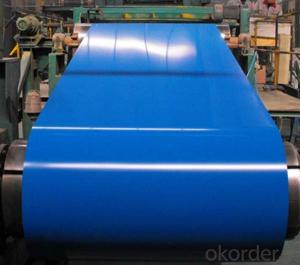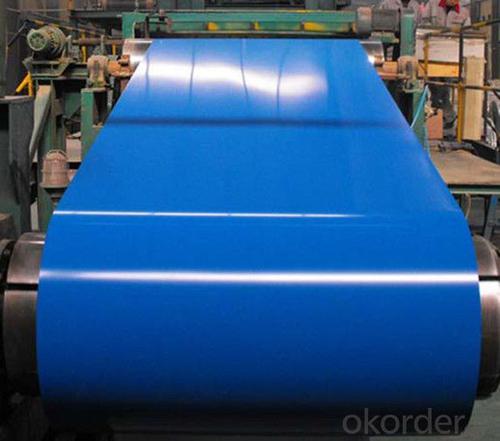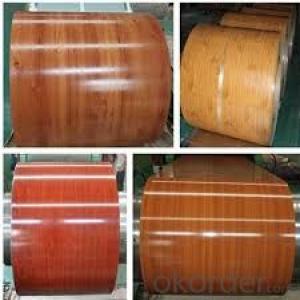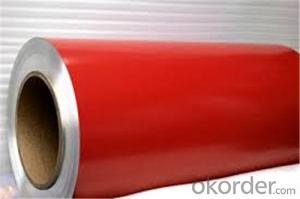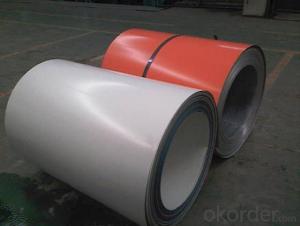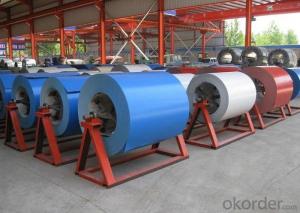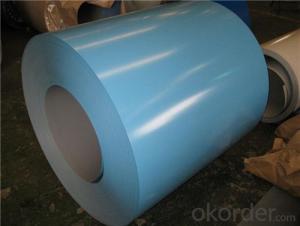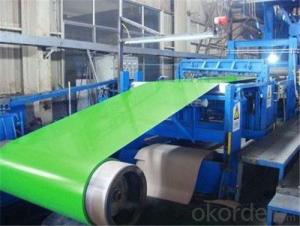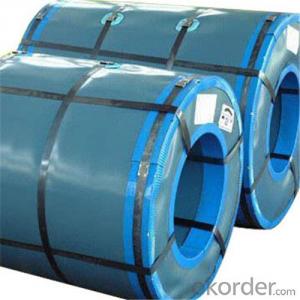Pre-painted Rolled Coil for Construction Roofing Constrution
- Loading Port:
- Tianjin
- Payment Terms:
- TT OR LC
- Min Order Qty:
- 25 m.t.
- Supply Capability:
- 25 m.t./month
OKorder Service Pledge
OKorder Financial Service
You Might Also Like
Structure of Prepainted Rolled steel Coil for Construction Roofing
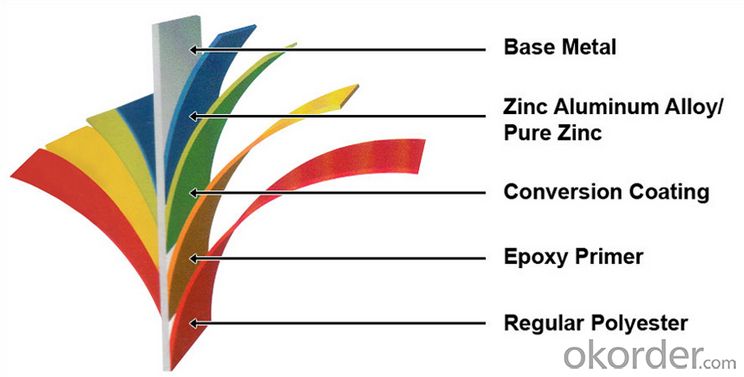
Description of Prepainted Rolled steel Coil for Construction Roofing
Prepainted Rolled steel Coil is a kind of coated steel coil/sheet. With the cold rolled steel of different strength and thickness as substrate, it is produced through applying Al-Zn coat on both faces by hot dip process. In its coating, Al accounts for about 55%, Si 1.6%, while the remaining is Zn. Aluminum zinc coils enjoys both the physical protective feature and durability of Al and the electrochemical protective property of Zn. And its surface has bright silver color and regular embossed-like figure, which are highly decorative.
Main Feature of Prepainted Rolled steel Coil for Construction Roofing
1.Corrosion resistance: It mainly depends on the aluminum protection. When the zinc being worn, the aluminum will form a dense layer of aluminum oxide, resist corrosion material to prevent further corrosion inside.
2. Heat resistance: Aluminum zinc alloy steel sheet has excellent heat resistance, can withstand high temperatures over 300 centigrade, and is similar with aluminized steel high temperature oxidation resistance. It often used in chimney pipes, ovens, fluorescent lighting device and the device cover.
3. Heat reflective: Galvanized steel plate heat-reflective high rate is twice as galvanized steel, often used to make insulation materials.
4. Economy: Because density of 55% AL-Zn is smaller than the density of Zn, so in the same weight and thickness of Galvanized zinc layer, aluminum-zinc steel plate is larger area more than 3% of galvanized steel sheet.
Applications of Prepainted Rolled steel Coil for Construction Roofing
1. Construction and building: roofing; ventilating duct; handrail; partition panel;etc.
2. Electric appliance: refrigerator; washing machine; refrigerator; DVD;etc.
3.Transportation: oil tank; road sign; etc.
4.Agriculture:barn; etc.
5.Others:vending machine; game machine; etc.
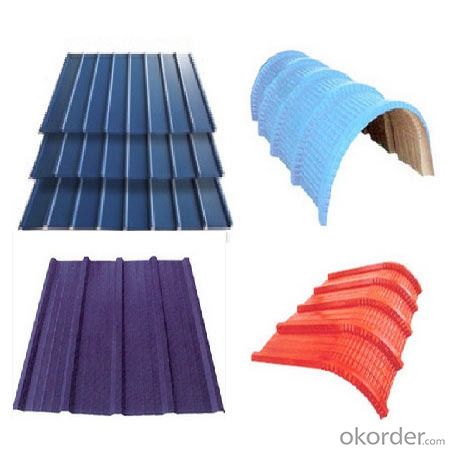
Specifications of Rolled steel Coil for Construction Roofing
Product | Prepainted Rolled steel Coil for Construction Roofing |
Material Grade | SGCC / SGCH / DX51D+AZ, etc |
Thickness | 0.2-3.0mm |
Width | 600-1500mm |
Tolerance | Thickness: +/-0.02mm , Width:+/-2mm |
Zinc-coating | AZ40-150g/m2 |
Technique | Raw material: Hot rolled steel coil --> Cold rolled_>hot dipped galvalume |
Surface | Dried, Chromated, Unoiled |
Spangle | Regular spangle , small spangle, zero spangle |
ID | 508MM |
Coil weight | 10MT max |
Export package | Cardboard inner sleeves, Waterproof paper, galvanized steel covered and steel strip packed |
FAQ of Prepainted Rolled steel Coil for Construction Roofing
We have organized several common questions for our clients,may help you sincerely:
1. What is the minimum order quantity ?
Our MOQ is 50mt for each size. And we will consider to give more discount if you make big order like 1000 tons and more. Further more, the more appropriate payment term your offer the better price we can provide.
2. How long can we receive the product after purchase?
Usually within thirty working days after receiving buyer’s advance payment or LC. We will arrange the factory manufacturing as soon as possible. The cargo readiness usually takes 15-25 days, but the shipment will depend on the vessel situation.
3. How to guarantee the quality of the products?
We have established the international advanced quality management system,every link from raw material to final product we have strict quality test;We resolutely put an end to unqualified products flowing into the market. At the same time, we will provide necessary follow-up service assurance.
- Q: How are steel coils used in the manufacturing of lighting fixtures?
- Steel coils are used in the manufacturing of lighting fixtures as they provide a sturdy and durable structure for the fixtures. The coils are typically shaped and formed to create the desired shape and design of the lighting fixture, ensuring its strength and stability. Additionally, the steel coils can be coated or painted to enhance the aesthetics of the fixture, making it more visually appealing.
- Q: 1045 surgical steel.
- There are many ways to sharpen knives. I guess your question is whether to use the steel that comes with knives, or a stone. Steels are only to straighten the edge, which is stropping. They won't sharpen a truly dull knife. For that you need a real sharpening system, of which a whet stone is one. The edge of a knife will get wavy with use - that's what the steel is for, to true it back up.
- Q: How are steel coils processed for slitting or shearing?
- Steel coils are processed for slitting or shearing by first unwinding the coil and then passing it through a set of rotating circular blades. The blades cut the steel coil into narrower strips, which are then either rewound into smaller coils (slitting) or cut into individual sheets (shearing). This process allows for the production of various sizes and shapes of steel products for different applications.
- Q: How are steel coils used in the manufacturing of automotive springs?
- Steel coils are used in the manufacturing of automotive springs as they provide the necessary strength and flexibility required to support the weight of the vehicle and absorb shocks and vibrations. The steel coils are shaped and tempered to specific dimensions and then coiled to form the springs, which are then installed in various parts of the vehicle's suspension system to ensure smooth and stable ride quality.
- Q: Steel is a mixture of Iron Carbon . So , is steel a metal or non - metal ?
- steel is an alloy - mix of two meatls alloy is a mixture and metal is an element so no comparision
- Q: What are the common coil loading and unloading techniques?
- Some common coil loading and unloading techniques include using overhead cranes or forklifts to lift and move the coils, using coil cars or transfer tables to transport coils within a facility, utilizing coil hooks or C-hooks to securely hold and transport coils, and employing coil tilters or turnstiles to rotate or position coils for loading or unloading.
- Q: i got a strip of steel from lowes how to sharpen it its not that thick its kinda slim but its heavyish its around 4'2 feet tall i cant get a whetstone or anything elsei have a brick , sand paper , and a hammer and some charcoal i was heating it up and trying to pound a edge into italso how to cut the steel to make a pointy curved tip any help appreciated and please tell me easy methodsplus its not sharp at all
- Comp is right- Lowe's sold you mild steel. Good for a lot of things, but holding an edge isn't one. If you want to make some sort of edged tool, try something like Smokey Mountain Knife Works or another online vendor. They have better blades, even some Damascus blades which will hold an edge much better. If you want to make your own blades, you'll need to start with better steel and build your own forge. I made one from a brake drum and a vacuum with a dimmer switch. You'll also need an anvil, something that may be a bit tough to locate. A couple of hammers and you can start forging blades. For something simpler, locate a place where you can learn blacksmithing and forging. Some art classes teach this at a community college, but not many. Check the site below and see if you can go with ABANA. ... Good luck!!
- Q: I want to know where cold formed steel framing is used, is every steel frame we see in a construction sites like houses, building and bridges cold formed steel frames? or hot formed steel framing?I also read that cold formed steel framing is used for floors, is the steel frame beneath the floor's concrete cover?Thank u very much!!
- Abeer: I'm a civil/structural engineer. Cold-formed (or rolled) steel framing is typically limited to facades, studs in lightly-loaded bearing walls and non-load bearing wall studs. Hot-rolled steel members are typically used to frame steel buildings and bridges. See the article below on cold-formed steel framing.
- Q: What are the factors affecting the formability of steel coils?
- The factors affecting the formability of steel coils include the composition and microstructure of the steel, the thickness and width of the coil, the temperature and speed of the forming process, the lubrication used during forming, and the presence of any surface defects or contaminants.
- Q: What are the different methods of forming steel coils into sheets?
- There are several methods of forming steel coils into sheets, each with its own advantages and applications. 1. Hot rolling: This is the most common method used to form steel coils into sheets. In this process, the steel is heated above its recrystallization temperature and then passed through a series of rollers. The rollers apply pressure to the heated steel, reducing its thickness and elongating it into a sheet. Hot rolling produces sheets with a smooth surface finish and is suitable for a wide range of applications. 2. Cold rolling: This method involves passing the steel coil through rollers at room temperature. Unlike hot rolling, cold rolling does not require heating the steel. The cold rolling process results in sheets with a higher dimensional accuracy and a smoother surface finish. Cold-rolled sheets are often used in applications where precise dimensions and a polished appearance are required, such as automotive body panels and appliances. 3. Annealing and pickling: This method involves subjecting the steel coil to a heat treatment process called annealing, followed by pickling. Annealing involves heating the steel to a specific temperature and then slowly cooling it, which helps to relieve stress and improve the material's mechanical properties. Pickling is the process of removing impurities and scale from the steel surface. These steps are typically performed before hot or cold rolling to ensure a high-quality end product. 4. Galvanizing: Galvanizing is a process that involves coating steel sheets with a layer of zinc to provide corrosion resistance. The steel coil is first cleaned and then immersed in a bath of molten zinc. The zinc adheres to the surface of the steel, forming a protective layer that prevents rust and corrosion. Galvanized sheets are commonly used in construction, automotive manufacturing, and electrical appliances. 5. Electro-galvanizing: This method is similar to galvanizing, but instead of immersing the steel coil in a bath of molten zinc, an electric current is used to deposit zinc onto the surface of the steel. Electro-galvanizing offers similar corrosion resistance to traditional galvanizing but with a thinner coating. It is often used in applications where a thinner, more lightweight sheet is desired. In summary, the different methods of forming steel coils into sheets include hot rolling, cold rolling, annealing and pickling, galvanizing, and electro-galvanizing. Each method has its own advantages and is suitable for different applications based on the required surface finish, dimensional accuracy, and corrosion resistance.
Send your message to us
Pre-painted Rolled Coil for Construction Roofing Constrution
- Loading Port:
- Tianjin
- Payment Terms:
- TT OR LC
- Min Order Qty:
- 25 m.t.
- Supply Capability:
- 25 m.t./month
OKorder Service Pledge
OKorder Financial Service
Similar products
Hot products
Hot Searches
Related keywords
